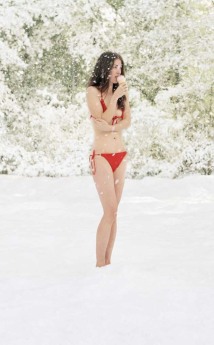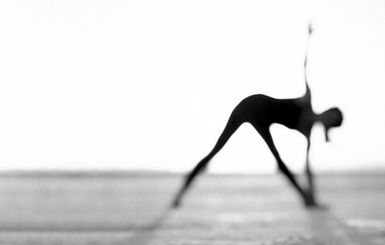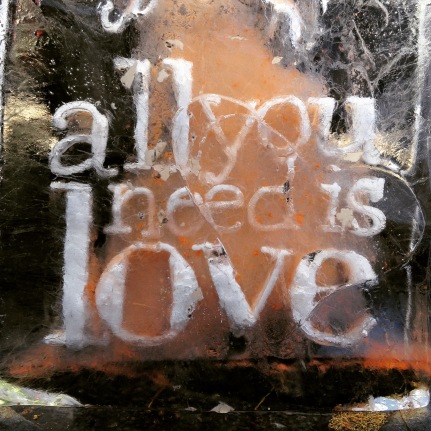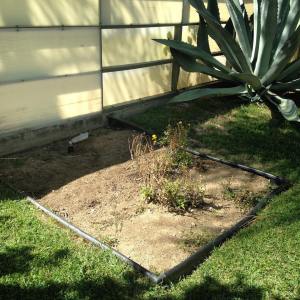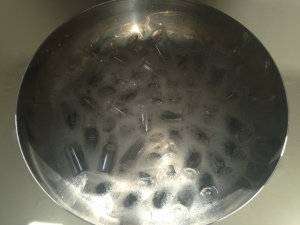
Winter solstice is a good time to look inward and reflect on the past year as well as prepare for the seasons to come. It is the shortest day of the year and the longest night allowing one to enter a powerful dream/wake state.
I grew up with the Persian New Year (Nou Ruz) as the first day of spring which made a lot of sense to me, but I’m learning to appreciate the mystical power of the winter new year rooted in ancient traditions that span different cultures including that of the Zoroastrians who celebrated Shab-e-Yalda, the longest night of the year. Marking the dialectical forces of good and evil, light and dark, it was important to remain vigilant all night so that sunrise could be greeted with the triumph of optimism.
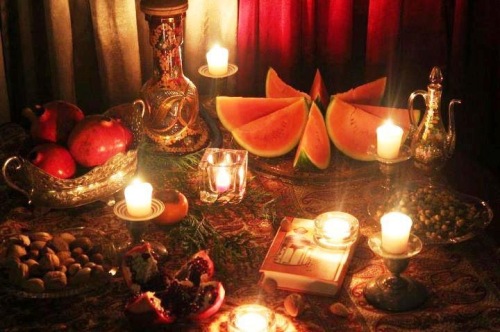
Shab-e-Yalda table courtesy of Isabel’s Beauty Authority Blog
The modern tradition of Shab-e-Yalda includes gathering around the “korsi”, a low table covered with blankets where a charcoal brazier underneath provides warmth. Dried fruits and nuts are served along with pomegranates and watermelon, a summer fruit that has been kept in cold storage, (“sard khooneh”, literally cold house or root cellar), until this night. Candles remain lit and poetry is recited all night until sunrise.

Persians have a close cultural connection to poetry. Children memorize poems at a young age. My father can carry on whole conversations with his friends by quoting poems embedded in deep mysticism that transcends religion. It’s more like a meditation than anything else.

Jan Davidsz de Heem 1662
I recently rekindled my meditation practice which began when I was 14 years old. My art teacher, Jeanne Morris, a young painter who lived on campus with her husband, a graduate student, recommended I learn how to meditate to help me focus. I attended the lectures at the Tehran American Cultural center which culminated in a private audience with a Guru who very well may have been the Maharishi of Beetles fame. I remember sitting with him in a quiet dark room after having offered a gift of fruit and flowers. He sat for a while and then transmitted a mantra to me. He explained this was a sound unique to my vibration that should not be shared with anyone else. He then explained the mechanics of how to use the mantra and we meditated together for 16 minutes.
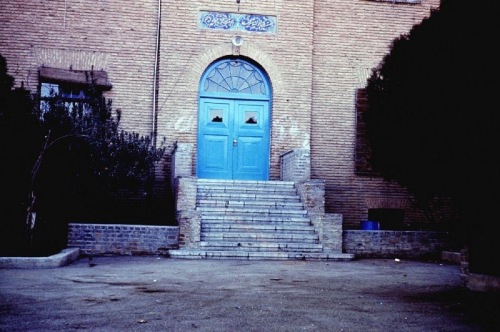
Entrance to The Community School, Tehran, Iran courtesy csreunion.com
After I received my mantra I would sit with Jeanne during free period and we would meditate. She was unique and unconventional in that way. She also had long black hair, wore long black dresses and rimmed her green eyes with “sormeh”, Persian kohl. I never considered myself a particularly talented art student, but I think she recognized the importance creativity would have in my life. It did not matter how it would manifest itself, just that it would be nurtured.
In the many years that have followed, I have turned to meditation to calm myself (when flying in airplanes) or during yoga or while walking, but I’ve always had trouble practicing regularly…until recently. To say I had a breakthrough would be an understatement. It’s more like a revolution causing all the pieces to fall into place. It probably would not have happened without the evolution that took place over the years. The tipping point was actually quite simple, having to do with transition.
All this time I thought I just had to sit still, focus on my third eye and repeat my mantra with my breath. What I never realized was that a deep meditative stage could not be reached without some form of conscious transition. It actually makes a lot of sense because any type of meditation removes one from the outside world to to an inner state of being. I could never get there because I didn’t know how to make the transition.
The following are a series of notes I wrote after my breakthrough. They are various breathing exercises that can help one transition into a meditative state. They have not been edited in an effort to retain their immediacy. I hope they help others achieve similar breakthroughs with their inner journey.
Transition from outside world to inner state of being.
Place the body.
Still the body.
Draw energy from the outside into body through extremities/astral body to the inner core of being, the breath/heart area.
Breathing exercises as a way to transition into a meditative state:
1. The World is a Part of Me/I Am a Part of the World
-Breathe in and say inwardly “the world is a part of me”, as one is indeed drawing the world into the body with each breath.
-Breathe out and say inwardly “I am a part of the world”, as with every exhalation the body is being put forth into the world.
2. Recognize the shifting point of each breath from in/out as a conscious pause.
-Breathe in steadily and hold the breath for the same number of counts/heartbeats.
-Breathe out steadily and hold the breath for the same number of counts/heartbeats.
3. Belly Breathing UP/DOWN
-Up by pulling breath in/up to crown chakra. Pause.
-Down by pushing breath out/down to base of seat chakra. Pause.
-Down by pulling breath in/down to base of seat chakra. Pause.
-Up by pushing breath out/up to crown chakra. Pause.
4. Belly Breathing IN/OUT
-In by pulling navel into spine. Pause.
-Out by pushing navel out. Pause.
-Out by pushing navel into spine. Pause.
-In by pushing navel out. Pause.
5. Breath as HORIZONTAL WAVE
-Imagine breathing to be the waves of the ocean and a continuous rhythm.
6. Belly Breath as CIRCULAR WAVE
-Using belly to push and pull breath in a circular wave alternating outward/inward rotations. Continuous in/out breath focusing on there being no pause between in and out.
7. STILL Breath
-Breathe as still as possible so that there is no perception between in breath and out breath.
Meditative state is when all senses are suspended and one is pure spirit. Allow body to remain in suspension of time. Without will or resistance. Just being. The body will tell you when it is ready to return to conscious space.
Return back to conscious space and re-occupy the body. Bring consciousness back to the breath. Radiate consciousness back out from inner core of being, breath/heart to extremities. Radiate body energy back out into space.
Awareness of what it is like to re-occupy the body and the difference in feeling of one’s astral container. Body is a container of energy that can simultaneously draw in and radiate out. Meditation helps achieve balance of energy exchange.
Winter Solstice is an in breath, the breath of anxiety and holding in. Summer Solstice is the outbreath, the breath of release and joy. Midpoints between the in breath and out breath are the Equinoxes.
Advent is the period of preparation for the darkest day of the year where we celebrate to off set our collective anxiety regarding the return of light in our lives.
Please share thoughts. It would be great to learn what others have experienced. Happy Winter Solstice!


 My garden has been my productive ally for almost 12 years, nourishing my family and providing many of the plants needed to create extractions for my Lalun products.
My garden has been my productive ally for almost 12 years, nourishing my family and providing many of the plants needed to create extractions for my Lalun products. In addition, I have wildcrafted for many years because I believe wild plants are inherently stronger due to natural selection. They tend to be natives of a particular region or climate and define the context within which we live. It makes sense to partake of something just within reach. We reduce our carbon footprint when we incorporate locally grown plants into our lives and wild plants are uniquely connected to the seasons. Unlike their cultivated counterparts, they cannot be harvested unless they are in season. This encourages us to be more in touch with the cycles of the year.
In addition, I have wildcrafted for many years because I believe wild plants are inherently stronger due to natural selection. They tend to be natives of a particular region or climate and define the context within which we live. It makes sense to partake of something just within reach. We reduce our carbon footprint when we incorporate locally grown plants into our lives and wild plants are uniquely connected to the seasons. Unlike their cultivated counterparts, they cannot be harvested unless they are in season. This encourages us to be more in touch with the cycles of the year.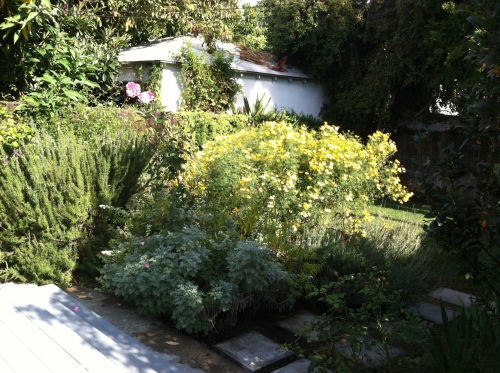 My garden has always been organic. I learned about biodynamics after my daughter attended a Waldorf school, participating in stirs and applying the preps. I turned my garden into a closed system where composting was key. Since I had also been working with wild plants, it occurred to me that I could combine the two. So I stopped pruning, removing leaf detritus, fertilizing, weeding and watered only minimally. I called my gardening method “wildgrowing” and proceeded to welcome volunteers, propagate native wild plants from seed or cuttings, allowing leaf detritus to mulch and fertilize,
My garden has always been organic. I learned about biodynamics after my daughter attended a Waldorf school, participating in stirs and applying the preps. I turned my garden into a closed system where composting was key. Since I had also been working with wild plants, it occurred to me that I could combine the two. So I stopped pruning, removing leaf detritus, fertilizing, weeding and watered only minimally. I called my gardening method “wildgrowing” and proceeded to welcome volunteers, propagate native wild plants from seed or cuttings, allowing leaf detritus to mulch and fertilize,  watering intermittently and not pruning. The idea was to simulate how plants would grow in the wild while maintaining the closed system of a biodynamic garden.
watering intermittently and not pruning. The idea was to simulate how plants would grow in the wild while maintaining the closed system of a biodynamic garden.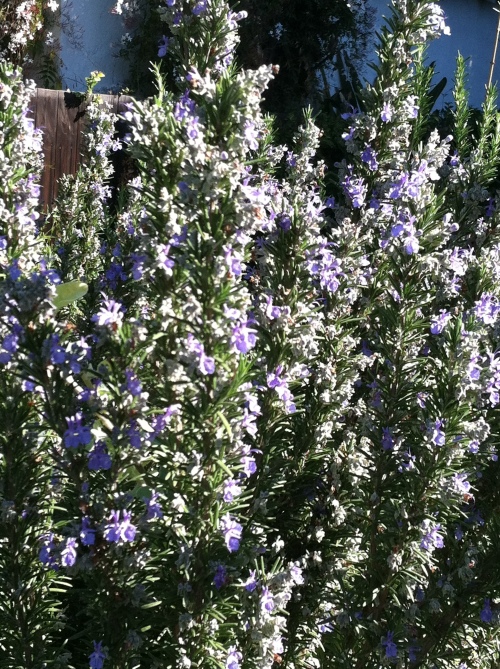 Winter rose hips were harvested to make healing oxymels and skincare extracts.
Winter rose hips were harvested to make healing oxymels and skincare extracts.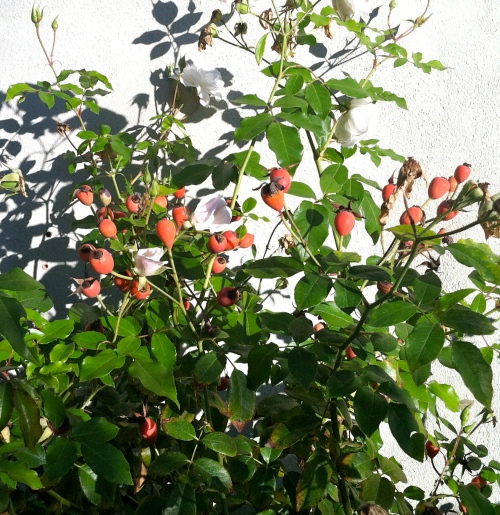 Plants would reseed. By not sweeping away dead leaves and detritus, mulch resulted that would help retain moisture in the soil and provide nutrients once the leaves had broken down. If you got down and peered under those dead leaves, you would find the earth teeming with life. Allowing the weeds to grow meant I could welcome new plants into the mix. It was fun guessing what would sprout up next.
Plants would reseed. By not sweeping away dead leaves and detritus, mulch resulted that would help retain moisture in the soil and provide nutrients once the leaves had broken down. If you got down and peered under those dead leaves, you would find the earth teeming with life. Allowing the weeds to grow meant I could welcome new plants into the mix. It was fun guessing what would sprout up next. I had been wildcrafting many of those plants, but as the summers got hotter and more intense, I began to question the soundness of wildcrafting in such a sensitive environment. The first wild plant to inhabit my garden was Artemisia californica or cowboy cologne
I had been wildcrafting many of those plants, but as the summers got hotter and more intense, I began to question the soundness of wildcrafting in such a sensitive environment. The first wild plant to inhabit my garden was Artemisia californica or cowboy cologne and it grew well for a while. Next I added mugwort
and it grew well for a while. Next I added mugwort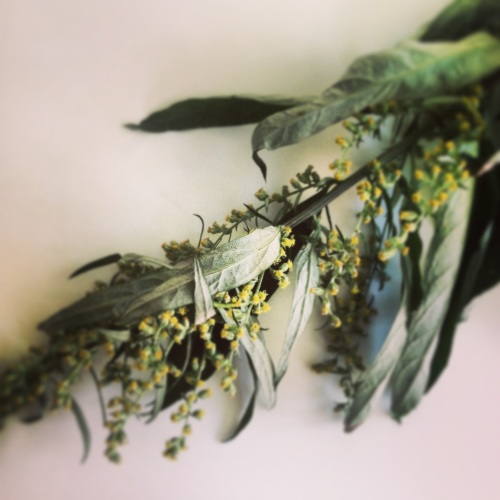 followed by rose geranium, horehound,
followed by rose geranium, horehound, wild mint,
wild mint,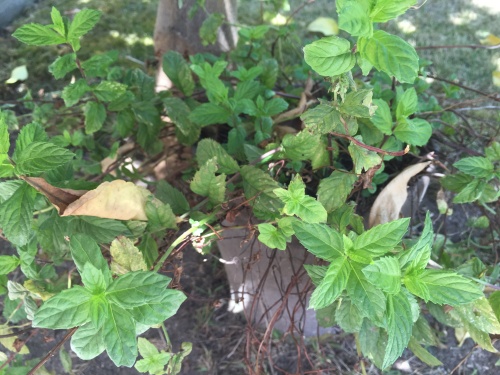 white sage,
white sage,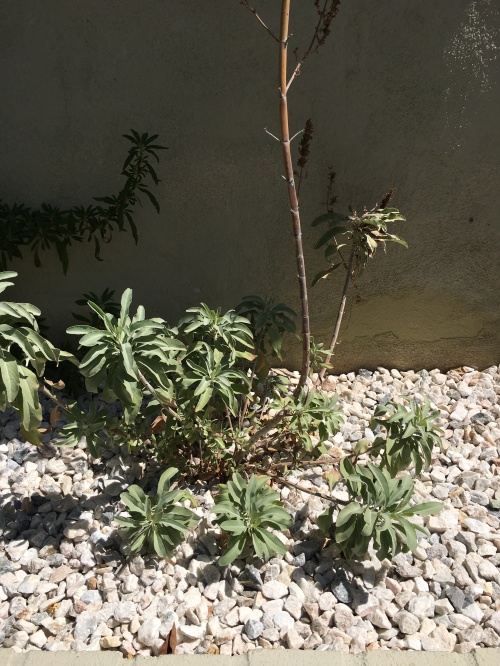 black sage
black sage and wild fennel.
and wild fennel. I have also had volunteers like winter jasmine,
I have also had volunteers like winter jasmine,
 chamomile
chamomile and wild carrot.
and wild carrot. Of course there’s plantain and dandelion which grow all over the world. Everyone’s a bit scruffy as I work out my method, but my garden has become a slice of nature in the city.
Of course there’s plantain and dandelion which grow all over the world. Everyone’s a bit scruffy as I work out my method, but my garden has become a slice of nature in the city.


 from the initial cutting I planted ten years ago. Along the way I’ve learned a lot about my plants and their life cycles from birth to death and how to give them a fighting chance. While some plants thrive and persist, others fail and die. I’ve learned to work with this reality. The eventual success of a wild garden depends not only on the plants that thrive, but also on the ones that fail. That’s how it is in nature and that’s how it unfolds in my perfectly imperfect, wild garden.
from the initial cutting I planted ten years ago. Along the way I’ve learned a lot about my plants and their life cycles from birth to death and how to give them a fighting chance. While some plants thrive and persist, others fail and die. I’ve learned to work with this reality. The eventual success of a wild garden depends not only on the plants that thrive, but also on the ones that fail. That’s how it is in nature and that’s how it unfolds in my perfectly imperfect, wild garden.









